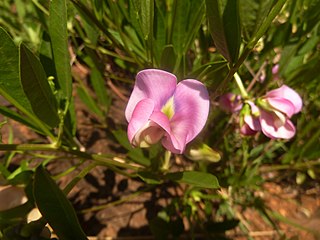
Herring are forage fish, mostly belonging to the family Clupeidae.

Parmentiera cereifera, the candle tree, is a species of tree in the family Bignoniaceae. It is endemic to Panama, but it is also a commonly cultivated specimen in botanical gardens.
This article is a list of biological species, subspecies, and evolutionary significant units that are known to have become extinct during the Holocene, the current geologic epoch, ordered by their known or approximate date of disappearance from oldest to most recent.
Knema stenocarpa is a species of plant in the family Myristicaceae. It is endemic to the Philippines.
Ladenbergia stenocarpa is a species of plant in the family Rubiaceae. It is endemic to Peru.
Parmentiera dressleri is a species of plant in the family Bignoniaceae. It is endemic to Panama and Costa Rica. It is threatened by habitat loss.
Parmentiera morii is a plant species in the family Bignoniaceae. It is endemic to Panama. It is threatened by habitat loss.
Weinmannia stenocarpa is a species of plant in the family Cunoniaceae. It is endemic to Ecuador. Its natural habitats are subtropical or tropical moist montane forests and subtropical or tropical high-altitude shrubland.
Bat Conservation International (BCI) is an international nongovernmental organization working to conserve bats and their habitats through conservation, education, and research efforts.

Sphenostylis is a genus of flowering plants in the legume family, Fabaceae. It belongs to the subfamily Faboideae. Sphenostylis contains several species useful as food sources including Sphenostylis stenocarpa.

The World's 25 Most Endangered Primates is a list of highly endangered primate species selected and published by the International Union for Conservation of Nature (IUCN) Species Survival Commission (SSC) Primate Specialist Group (PSG), the International Primatological Society (IPS), Global Wildlife Conservation (GWC), and Bristol Zoological Society (BZS). The IUCN/SSC PSG worked with Conservation International (CI) to start the list in 2000, but in 2002, during the 19th Congress of the International Primatological Society, primatologists reviewed and debated the list, resulting in the 2002–2004 revision and the endorsement of the IPS. The publication was a joint project between the three conservation organizations until the 2012–2014 list when BZS was added as a publisher. The 2018–2020 list was the first time Conservation International was not among the publishers, replaced instead by GWC. The list has been revised every two years following the biannual Congress of the IPS. Starting with the 2004–2006 report, the title changed to "Primates in Peril: The World's 25 Most Endangered Primates". That same year, the list began to provide information about each species, including their conservation status and the threats they face in the wild. The species text is written in collaboration with experts from the field, with 60 people contributing to the 2006–2008 report and 85 people contributing to the 2008–2010 report. The 2004–2006 and 2006–2008 reports were published in the IUCN/SSC PSG journal Primate Conservation,, since then they have been published as independent publications.
Anthene pitmani, the Pitman's hairtail, is a butterfly in the family Lycaenidae. It is found in Ethiopia, Somalia and Kenya. The habitat consists of savanna.

Hakea stenocarpa is a shrub in the family Proteaceae, commonly known as narrow-fruited hakea. It has scented creamy-white flowers in clusters, often with curling leaves and is endemic to an area in the Mid West, western Wheatbelt, Peel and the South West regions of Western Australia.
Sphenostylis stenocarpa or the African yam bean is a species of plant in the Fabaceae which is native to Africa. It is an important source of food in many parts of Africa. The tubers are fried, boiled or roasted, and are higher than the seeds in protein.






